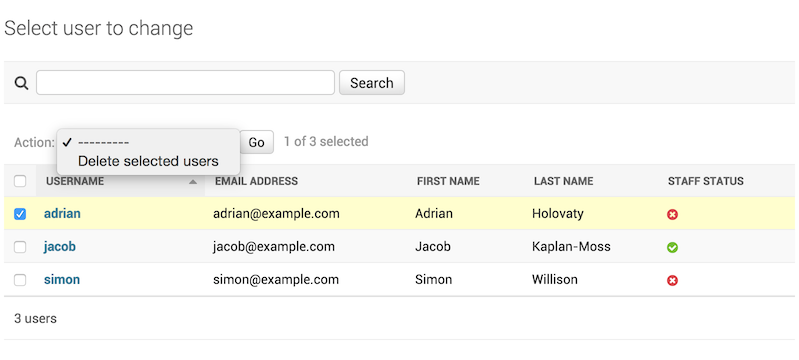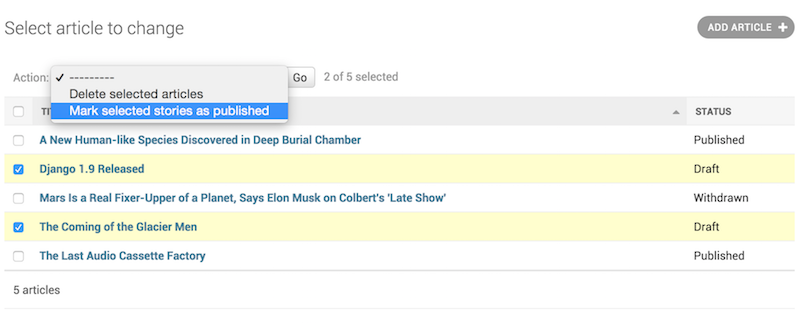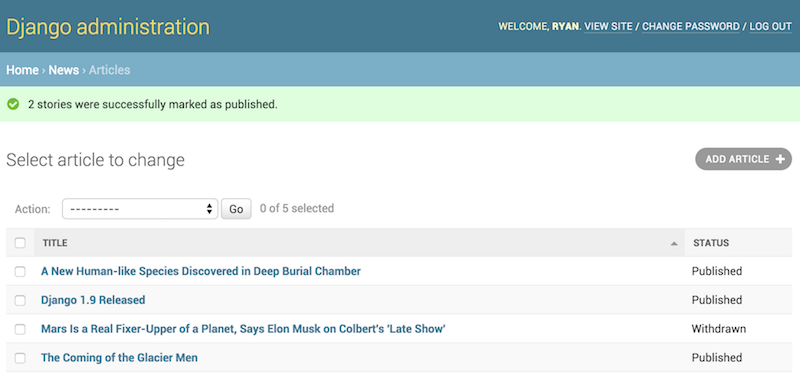管理动作¶
Django 的管理员的基本工作流程,简而言之,就是“选择一个对象,然后更改它”。这对于大多数用例来说都很好用。然而,如果你需要同时对许多对象进行相同的更改,这种工作流程可能会相当乏味。
在这种情况下,Django 的管理可以让你编写和注册“动作”——即使用在变更列表页面上选择的对象列表调用的函数。
如果你在管理中查看任何变化列表,你会看到这个功能的作用;Django 自带了一个“删除选定对象”的动作,所有模型都可以使用。例如,这里是 Django 内置的用户模块 django.contrib.auth 应用:

警告
“删除选定对象”动作使用 QuerySet.delete() 为了提高效率,它有一个重要的注意事项:你的模型的 delete() 方法将不会被调用。
如果你想覆盖这个行为,你可以覆盖 ModelAdmin.delete_queryset() 或者写一个自定义的动作,以你喜欢的方式进行删除 -- 例如,通过为每个选定的项目调用 Model.delete()。
关于批量删除的更多背景,请参见 对象删除 的文档。
请继续阅读,了解如何将自己的动作添加到此列表中。
编写动作¶
The easiest way to explain actions is by example, so let's dive in.
A common use case for admin actions is the bulk updating of a model. Imagine a
news application with an Article model:
from django.db import models
STATUS_CHOICES = [
('d', 'Draft'),
('p', 'Published'),
('w', 'Withdrawn'),
]
class Article(models.Model):
title = models.CharField(max_length=100)
body = models.TextField()
status = models.CharField(max_length=1, choices=STATUS_CHOICES)
def __str__(self):
return self.title
A common task we might perform with a model like this is to update an article's status from "draft" to "published". We could easily do this in the admin one article at a time, but if we wanted to bulk-publish a group of articles, it'd be tedious. So, let's write an action that lets us change an article's status to "published."
编写动作函数¶
First, we'll need to write a function that gets called when the action is triggered from the admin. Action functions are regular functions that take three arguments:
- The current
ModelAdmin - An
HttpRequestrepresenting the current request, - A
QuerySetcontaining the set of objects selected by the user.
Our publish-these-articles function won't need the ModelAdmin or the
request object, but we will use the queryset:
def make_published(modeladmin, request, queryset):
queryset.update(status='p')
注解
For the best performance, we're using the queryset's update method. Other types of actions might need to deal with each object individually; in these cases we'd iterate over the queryset:
for obj in queryset:
do_something_with(obj)
That's actually all there is to writing an action! However, we'll take one
more optional-but-useful step and give the action a "nice" title in the admin.
By default, this action would appear in the action list as "Make published" --
the function name, with underscores replaced by spaces. That's fine, but we
can provide a better, more human-friendly name by giving the
make_published function a short_description attribute:
def make_published(modeladmin, request, queryset):
queryset.update(status='p')
make_published.short_description = "Mark selected stories as published"
注解
This might look familiar; the admin's list_display option uses the
same technique to provide human-readable descriptions for callback
functions registered there, too.
在 ModelAdmin 中添加动作¶
Next, we'll need to inform our ModelAdmin of the action. This works
just like any other configuration option. So, the complete admin.py with
the action and its registration would look like:
from django.contrib import admin
from myapp.models import Article
def make_published(modeladmin, request, queryset):
queryset.update(status='p')
make_published.short_description = "Mark selected stories as published"
class ArticleAdmin(admin.ModelAdmin):
list_display = ['title', 'status']
ordering = ['title']
actions = [make_published]
admin.site.register(Article, ArticleAdmin)
That code will give us an admin change list that looks something like this:

That's really all there is to it! If you're itching to write your own actions, you now know enough to get started. The rest of this document covers more advanced techniques.
处理动作中的错误¶
If there are foreseeable error conditions that may occur while running your
action, you should gracefully inform the user of the problem. This means
handling exceptions and using
django.contrib.admin.ModelAdmin.message_user() to display a user friendly
description of the problem in the response.
进阶动作技巧¶
There's a couple of extra options and possibilities you can exploit for more advanced options.
作为 ModelAdmin 方法的动作¶
The example above shows the make_published action defined as a function.
That's perfectly fine, but it's not perfect from a code design point of view:
since the action is tightly coupled to the Article object, it makes sense
to hook the action to the ArticleAdmin object itself.
You can do it like this:
class ArticleAdmin(admin.ModelAdmin):
...
actions = ['make_published']
def make_published(self, request, queryset):
queryset.update(status='p')
make_published.short_description = "Mark selected stories as published"
Notice first that we've moved make_published into a method and renamed the
modeladmin parameter to self, and second that we've now put the string
'make_published' in actions instead of a direct function reference. This
tells the ModelAdmin to look up the action as a method.
Defining actions as methods gives the action more idiomatic access to the
ModelAdmin itself, allowing the action to call any of the methods
provided by the admin.
For example, we can use self to flash a message to the user informing them
that the action was successful:
from django.contrib import messages
from django.utils.translation import ngettext
class ArticleAdmin(admin.ModelAdmin):
...
def make_published(self, request, queryset):
updated = queryset.update(status='p')
self.message_user(request, ngettext(
'%d story was successfully marked as published.',
'%d stories were successfully marked as published.',
updated,
) % updated, messages.SUCCESS)
This make the action match what the admin itself does after successfully performing an action:

提供中间页的动作¶
By default, after an action is performed the user is redirected back to the original change list page. However, some actions, especially more complex ones, will need to return intermediate pages. For example, the built-in delete action asks for confirmation before deleting the selected objects.
To provide an intermediary page, return an HttpResponse
(or subclass) from your action. For example, you might write an export function
that uses Django's serialization functions to
dump some selected objects as JSON:
from django.core import serializers
from django.http import HttpResponse
def export_as_json(modeladmin, request, queryset):
response = HttpResponse(content_type="application/json")
serializers.serialize("json", queryset, stream=response)
return response
Generally, something like the above isn't considered a great idea. Most of the
time, the best practice will be to return an
HttpResponseRedirect and redirect the user to a view
you've written, passing the list of selected objects in the GET query string.
This allows you to provide complex interaction logic on the intermediary
pages. For example, if you wanted to provide a more complete export function,
you'd want to let the user choose a format, and possibly a list of fields to
include in the export. The best thing to do would be to write a small action
that redirects to your custom export view:
from django.contrib.contenttypes.models import ContentType
from django.http import HttpResponseRedirect
def export_selected_objects(modeladmin, request, queryset):
selected = queryset.values_list('pk', flat=True)
ct = ContentType.objects.get_for_model(queryset.model)
return HttpResponseRedirect('/export/?ct=%s&ids=%s' % (
ct.pk,
','.join(str(pk) for pk in selected),
))
As you can see, the action is rather short; all the complex logic would belong
in your export view. This would need to deal with objects of any type, hence
the business with the ContentType.
Writing this view is left as an exercise to the reader.
在整个网站上提供动作¶
-
AdminSite.add_action(action, name=None)¶ Some actions are best if they're made available to any object in the admin site -- the export action defined above would be a good candidate. You can make an action globally available using
AdminSite.add_action(). For example:from django.contrib import admin admin.site.add_action(export_selected_objects)
This makes the
export_selected_objectsaction globally available as an action named "export_selected_objects". You can explicitly give the action a name -- good if you later want to programmatically remove the action -- by passing a second argument toAdminSite.add_action():admin.site.add_action(export_selected_objects, 'export_selected')
Disabling actions¶
Sometimes you need to disable certain actions -- especially those registered site-wide -- for particular objects. There's a few ways you can disable actions:
禁用全站点动作¶
-
AdminSite.disable_action(name)¶ If you need to disable a site-wide action you can call
AdminSite.disable_action().For example, you can use this method to remove the built-in "delete selected objects" action:
admin.site.disable_action('delete_selected')
Once you've done the above, that action will no longer be available site-wide.
If, however, you need to re-enable a globally-disabled action for one particular model, list it explicitly in your
ModelAdmin.actionslist:# Globally disable delete selected admin.site.disable_action('delete_selected') # This ModelAdmin will not have delete_selected available class SomeModelAdmin(admin.ModelAdmin): actions = ['some_other_action'] ... # This one will class AnotherModelAdmin(admin.ModelAdmin): actions = ['delete_selected', 'a_third_action'] ...
禁用特定 ModelAdmin 的所有动作¶
If you want no bulk actions available for a given ModelAdmin, set
ModelAdmin.actions to None:
class MyModelAdmin(admin.ModelAdmin):
actions = None
This tells the ModelAdmin to not display or allow any actions,
including any site-wide actions.
有条件地启用或禁用动作¶
-
ModelAdmin.get_actions(request)¶ Finally, you can conditionally enable or disable actions on a per-request (and hence per-user basis) by overriding
ModelAdmin.get_actions().This returns a dictionary of actions allowed. The keys are action names, and the values are
(function, name, short_description)tuples.For example, if you only want users whose names begin with 'J' to be able to delete objects in bulk:
class MyModelAdmin(admin.ModelAdmin): ... def get_actions(self, request): actions = super().get_actions(request) if request.user.username[0].upper() != 'J': if 'delete_selected' in actions: del actions['delete_selected'] return actions
设置动作的权限¶
Actions may limit their availability to users with specific permissions by
setting an allowed_permissions attribute on the action function:
def make_published(modeladmin, request, queryset):
queryset.update(status='p')
make_published.allowed_permissions = ('change',)
The make_published() action will only be available to users that pass the
ModelAdmin.has_change_permission() check.
If allowed_permissions has more than one permission, the action will be
available as long as the user passes at least one of the checks.
Available values for allowed_permissions and the corresponding method
checks are:
'add':ModelAdmin.has_add_permission()'change':ModelAdmin.has_change_permission()'delete':ModelAdmin.has_delete_permission()'view':ModelAdmin.has_view_permission()
You can specify any other value as long as you implement a corresponding
has_<value>_permission(self, request) method on the ModelAdmin.
例子:
from django.contrib import admin
from django.contrib.auth import get_permission_codename
class ArticleAdmin(admin.ModelAdmin):
actions = ['make_published']
def make_published(self, request, queryset):
queryset.update(status='p')
make_published.allowed_permissions = ('publish',)
def has_publish_permission(self, request):
"""Does the user have the publish permission?"""
opts = self.opts
codename = get_permission_codename('publish', opts)
return request.user.has_perm('%s.%s' % (opts.app_label, codename))
Last update:
3月 04, 2021